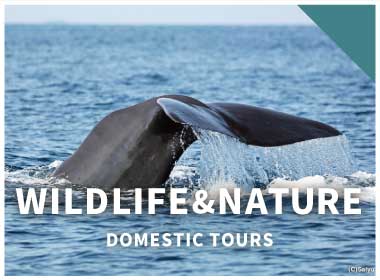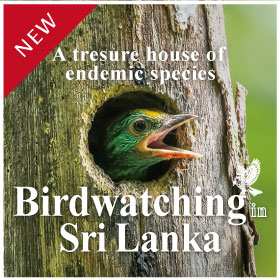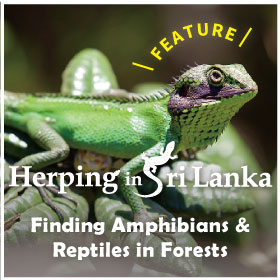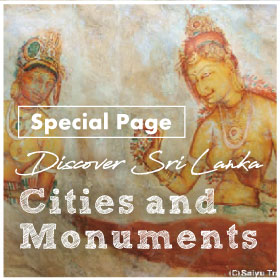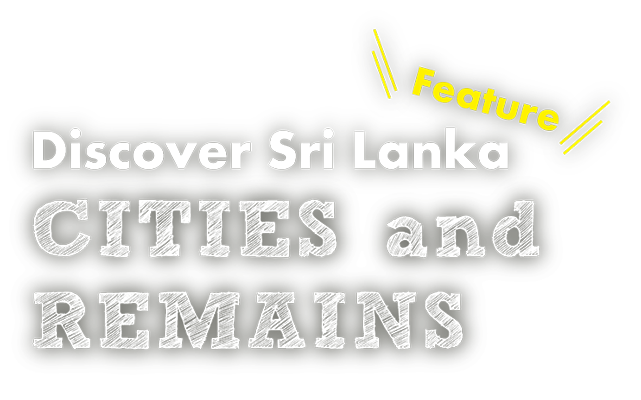- TOP
- Discover Sri Lanka Cities & Remains
There are a number of religious sites and historical places,
which attract tourists from all over the world.
HIghlights
Colombo and Surrounding area
Colombo
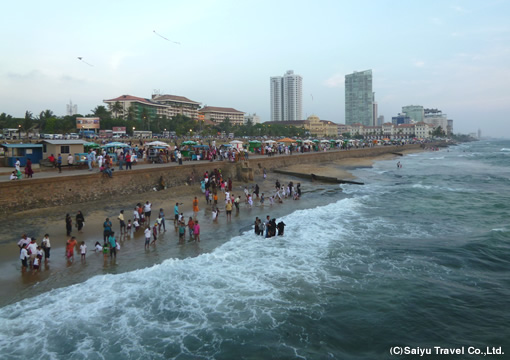
Galle Face Green
One is hard pushed to treat Colombo as a destination for historical sight seeing, which explains why few tourists hang about Colombo. But this is not to say that Colombo is devoid of places of interest. There are a number of old colonial buildings, old churches, temples, kovils and mosques and contemporary art galleries for culturally minded people. The museums are another good bet for killing a few hours. For those with an interest in eating out and nightlife, Colombo is a wonderful place, if you can afford it. Try it out your self A good way to do the tour would be to start at the northern end of the Fort and Pettah areas and work your way to the south. We kick off at St Anthony's Church, Kochchikade at the junction of St Anthony's Mawatha and Jam Pettah Street. This is an imposing Roman Catholic Church, patronized by worshippers of all faiths.
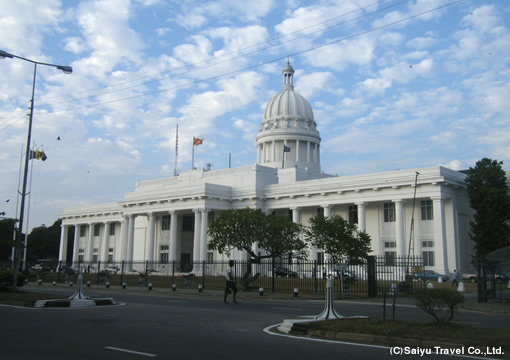
Town hall
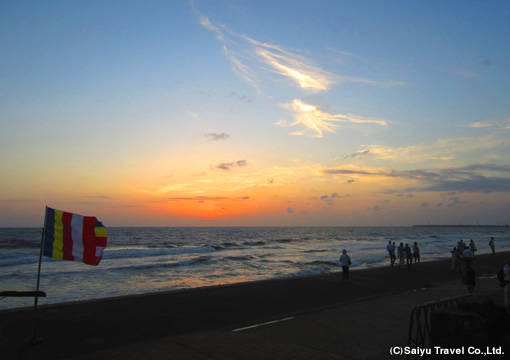
Sunset in Indian ocean
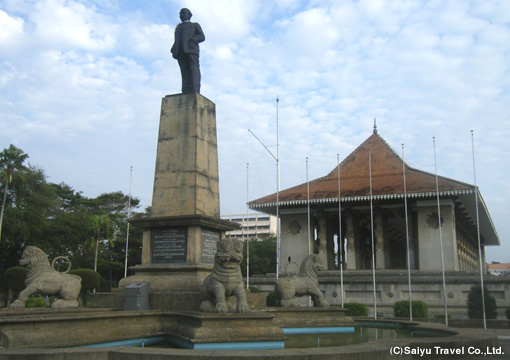
Independence Memorial Hall
Negombo
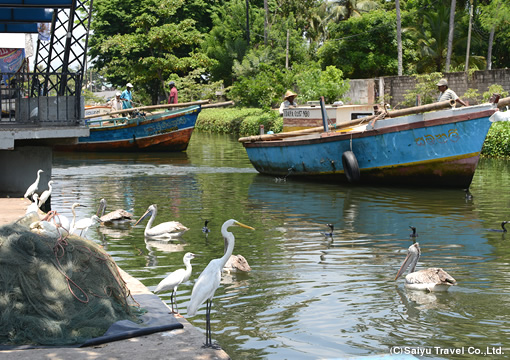
Hamilton Canal
Negombo is a town on the coast around 35km north of Colombo. Though it apparently is a modest beach town, it provides one of the most important bases for fishery in Sri Lanka. In the early morning and evening, you can see the landing of fish. The town’s tourism attractions include the Fish Market and the canal constructed during the Dutch colonial age. Hotels of every class from cheap hotels to resort hotels accommodate tourists to this town. Because this town is reachable with a 15 to 20 minutes drive from the Bandaranaike International Airport, the main gateway to this country, many foreigners stay in this town at the first or last night in their trips in Sri Lanka.
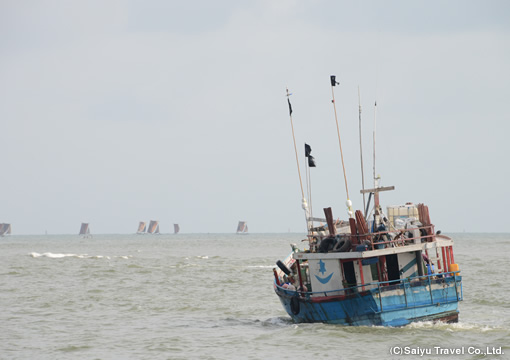
A fishing boat
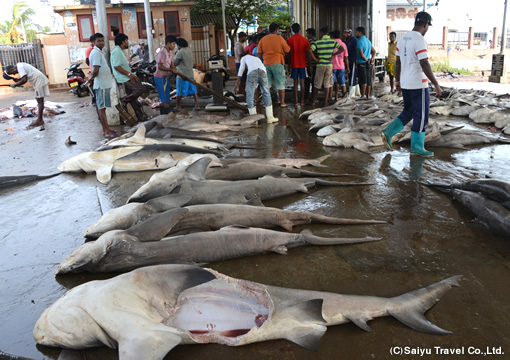
The Fish Market
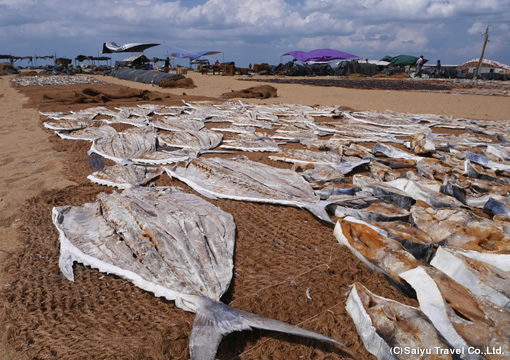
Fish dried near the Fish Market
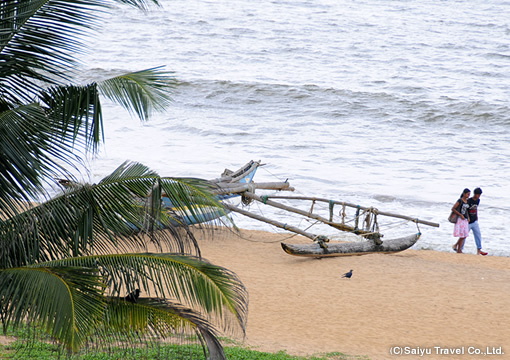
A beach
“Jetwing Lagoon”, a luxury hotel in Negombo, is a hotel designed by Geoffrey Bawa, the representative architect of Sri Lanka, located on the banks of Negombo Lagoon. In the popular “Bawa room” you will feel “the coexistence and fusion of nature and human beings”, the main theme of the Bawa’s architecture. Along the coast there stand many beach hotels, among which “Jetwing Blue” is one of the most popular. For those who do not have time to visit the beaches of the eastern or southern coasts, Negombo can be an alternative spot to enjoy the atmosphere of the tropical beach in.
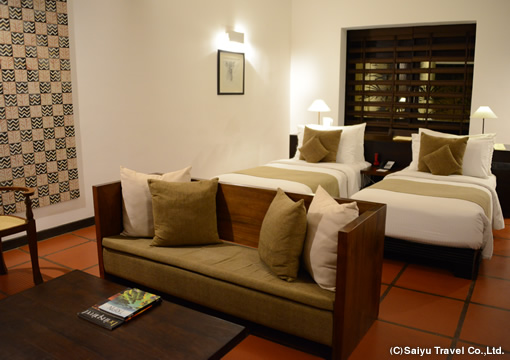
Jetwing Lagoon
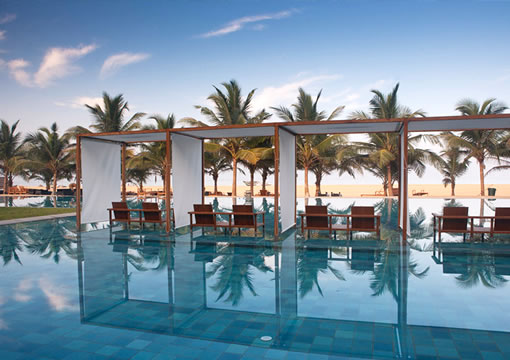
Jetwing Blue
Sigiriya & Cultural Triangle
Anuradhapura
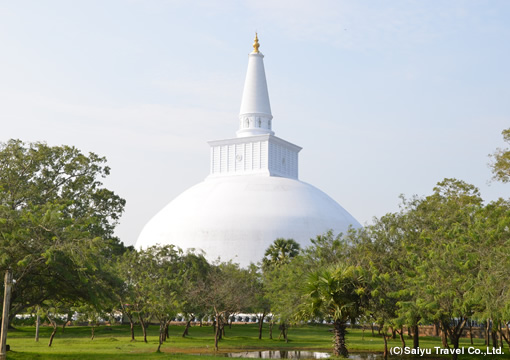
Ruwanweli Seya Dagoba
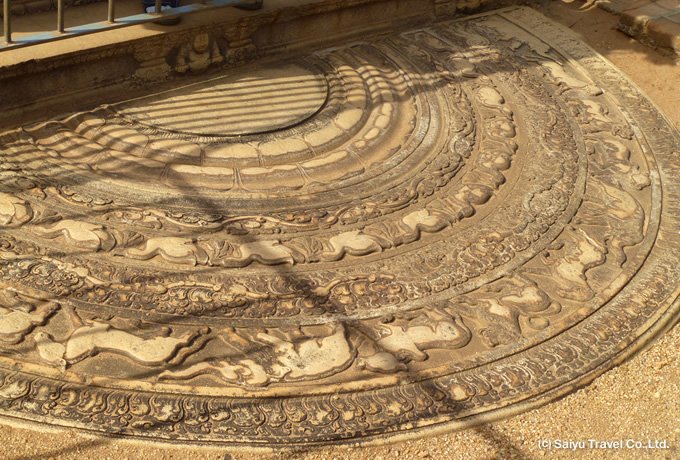
Moonstone
Anuradhapura is said that it is the most ancient holy city in Sri Lanka. It became a capital 2,400 years ago under King Pandukabhaya. After that, it became the central city of Buddhism and politics. The symbol is dagobas that is allover the town. To tour these remains, not only domestic tourists visit but tourists allover the world come and visit. Sri Maha Bodhi is what makes Anuradhapura a sacred place. In the 3rd centry B.C. an Indian queen of King Ashoka brought a sapling of the Bodhi Tree into Sri Lanka and Devanampiya Tissa, the King of Anuradhapura at the time, planted the tree and Buddhist monuments were established. Many pilgrims devote offerings and pray earnestly. Isurumuniya Vihara, a small temple made by rocks that is known as Rock temple, you will see the reclining Buddha. There is a stature that its named 「The Lovers」 in a treasury on the side of the main temple. It is said that this figures represent prince Saliya and his girlfriend Mala which they had different caste. The Sri Lanka’s most beautiful moon stone (normally a building that has a semicircular lithography in the bottom of the entrance stairs) is said that it’s the one at queen pavilion, where it used to be her building. 4 species of animals and birds, flowers are expressing transmigration. Abhayagiri Dagoba is what used to be Sri Lanka’s Mahayana head temple. It is 75 meters high and it is the highest existing dagoba. People say that in the 1st century B.C, it was 110 meters high. Near Abhayagiri Dagoba, there is Samadhi Buddha Statue surrounded by trees. The statues expression is gentle and gives peace to everybody that sees. Ruwanweliseya Dagoba, a pure white huge structure, is said that it is Anuradhapura’s symbol. King Dutugamunu built it in the 2nd century B.C. Other there is Thuparama Dagoda; an oldest hanging bell shaped structure in Anuradhapura, and Jetavana Dagoba; a huge structure build by bricks. For Sri Lanka’s 70% of Buddhist Sinhalese, Anuradhapura is a sacred place and a special place. To Know Sri Lanka, you may say you must go around the remains in Anuradhapura.
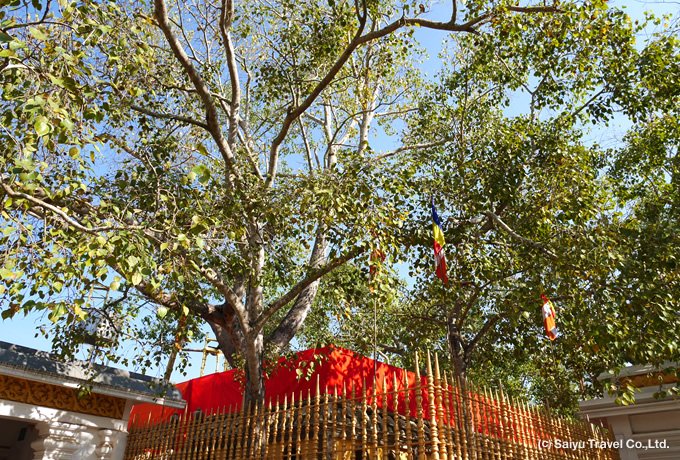
Bodhi Tree at Anuradhapura
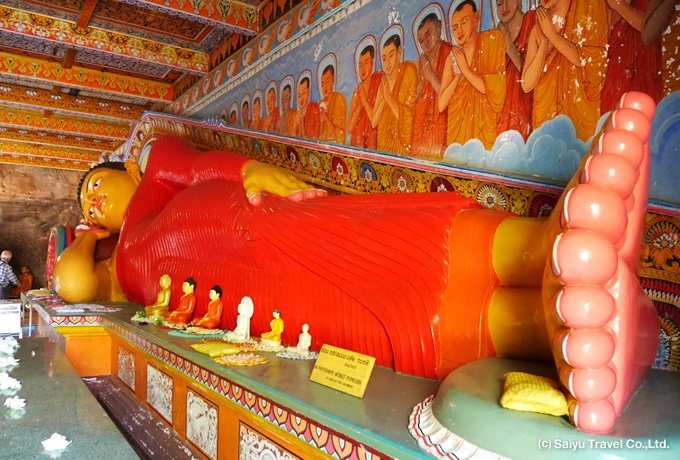
Nirvana in Isurumuniya Temple
Sigiriya
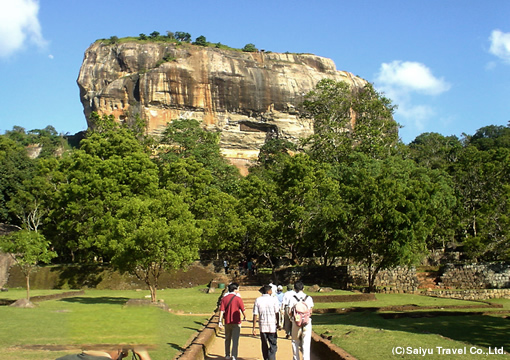
Sigiriya Rock
Sigiriya today is a UNESCO listed monument. It is one of the best preserved examples of ancient urban planning and also the most visited historic site in Sri Lanka. Sigiriya is an ancient Rock Fortress which is located near the town of Dambulla in the central province of Sri Lanka. The name refers to a site of historical and archaeological significance that is dominated by a massive column of rock approximately about 200 meters (660 ft) above sea level. This site was selected by King Kasyapa (477 – 495 CE) for his new capital. He built this palace on the top of the rock and decorated its sides with colorful frescoes. On a small plateau about halfway up the side of this rock he built a gateway in the form of a very big lion. The name of this place is derived from this structure — Sīhāgiri, which means the Lion Rock. After the death of the king in a battle this capital city and the royal palace was abandoned and it was used as a Buddhist monastery until the 14th century.
As per the legend, In 477 CE, Kashyapa, the King's son by a non-royal consort, seized the throne from King Dathusena following a coup assisted by Migara, the King's nephew and army commander. The rightful heir, Mugalan, fearing for his life Mugalan fled to South India. Now King Kashyapa also had a feeling that he will have to face an attack from Mugalan, so King Kashyapa moved the capital and his residence from the traditional capital of Anuradhapuram to the more secure Sigiriya. During King Kashyapa's reign (477 to 495 CE), Sigiriya was developed into a complex city and fortress. Most of the elaborate constructions on the rock summit and around it, including defensive structures, palaces, and gardens, date from King Kashyapas ruling period. Kashyapa was defeated in 495 CE by Mugalan and he moved the capital back to Anuradhapura, and Sigiriya was turned into a Buddhist monastery, which lasted until the 13th or 14th century. After this period, no records are found about Sigiriya until the 16th and 17th centuries, when it was used briefly as an outpost of the Kingdom of Kandy King Kashyapa was the son of King Dhatusena. Kashyapa murdered his father by walling him up alive and then usurping the throne which rightfully belonged to his brother Mogallana, who was Dhatusena's son by the true queen. Mogallana fled to India to escape being assassinated by Kashyapa but vowed revenge. In India he raised an army with the intention of returning and retaking the throne of Sri Lanka which he considered to be rightfully his. Knowing the inevitable return of Mogallana, Kashyapa is said to have built his palace on the summit of Sigiriya as a fortress and pleasure palace. Mogallana finally arrived and declared war. During the battle Kashyapa's armies abandoned him and he committed suicide by falling on his sword. In 1831 Major Jonathan Forbes of the 78th Highlanders of the British army, while returning on horseback from a trip to Pollonnuruwa, encountered the "bush covered summit of Sigiriya in the 1890s. H.C.P. Bell was the first archaeologist to conduct extensive research on Sigiriya. Sigiriya site contains the ruins of an upper palace located on the flat top of the rock, a mid-level terrace that includes the Lion Gate and the mirror wall with its frescoes, the lower palaces located behind the lavish lower gardens, and moats and ramparts which protected the citadel. The site was both a palace and a fortress. Frescoes The painting in on the ceiling of the location called the "Cobra Hood Cave" true identity of the ladies in these paintings still have not been confirmed. Different people have different ideas about the identity of these paintings. Some believe that they are the ladies of the king's while others think that they are women taking part in some kind of religious observances. These pictures have a close resemblance to paintings seen in the Ajanta Caves which are Located in India. The Mirror Wall Originally this wall was so highly polished that the king could see himself whilst he walked alongside it. Made of brick masonry wall and covered in highly polished white plaster, the wall is now partially covered with verses scribbled by visitors to the rock. The mirror wall has verses dating from as early as the 8th century The boulder gardens consist of several large boulders linked by winding pathways. They were used to be pushed off from the top to attack enemies when they approached. The terraced gardens are formed from the natural hill at the base of the Sigiriya rock. A series of terraces rises from the pathways of the boulder garden to the staircases on the rock. From this staircase, there is a covered path on the side of the rock, leading to the uppermost terrace where the lion staircase is situated.
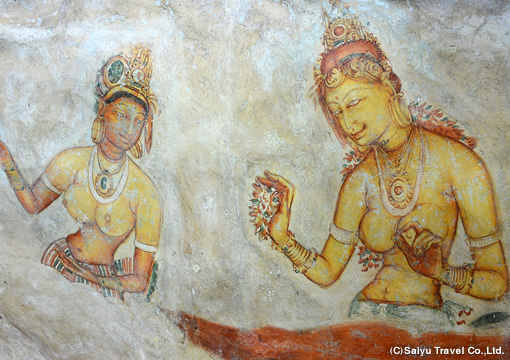
Frescoes of women
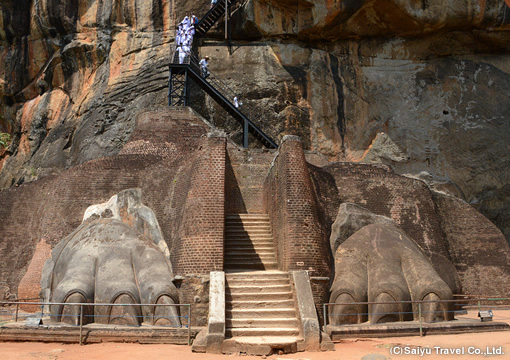
Lion's Gate
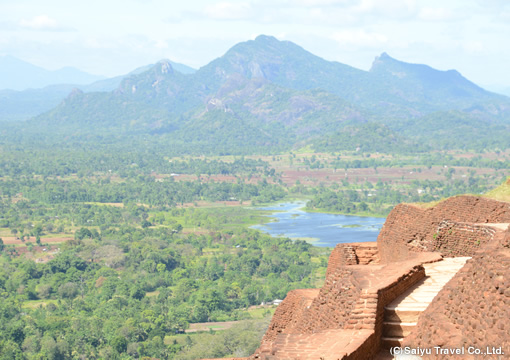
Top of Sigiriya Rock
Near the Sigiriya Rock is located “Heritance Kandalama”, the only Bawa’s hotel built inland. The hotel has the “Infinity Pool” with the view of Sigiriya Rock. It also has some other interesting features, which includes the design of a corridor which contains a natural rock in it as it is, which makes you feel the hotel is melt into nature. “Jetwing Vil Uyana” is also a popular hotel near Sigiriya, with the luxurious villas surrounded by rich nature.
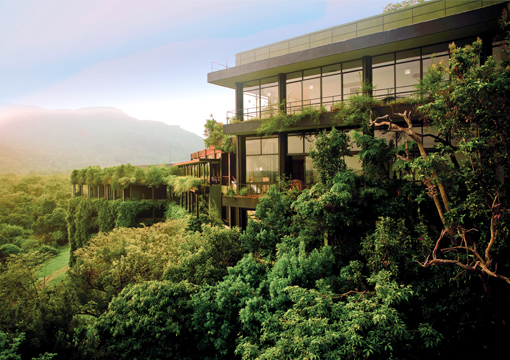
Heritance Kandalama
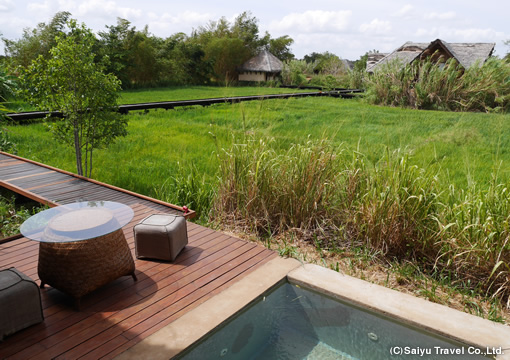
Vil Uyana
Polonnaruwa
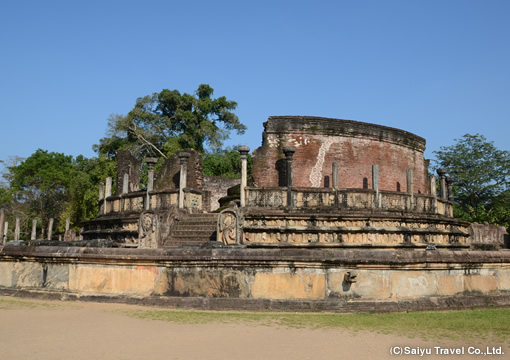
Circular pagoda, Vatadage
From the tenth century AD onwards the capital of the most powerful kingdom in the island shifted to Polonnaruwa from Anuradhapura. It was the capital from around 993 AD to 1250 AD. The greatest king of Polonnaruwa was Parakramabahu I (1153 –1186 AD). The whole area flourished under his 'golden reign'. Agriculture developed to its highest peak and Sri Lanka was also known as the 'Granary of the East'. With the new economic prosperity came several new building projects. The buildings were grand and impressive such as the Royal Palace and the Lankathilaka image house. The Gal Vihara with its great sculptures of the Buddha was created. The Culavamsa, a chronicle of records states that he repaired or built 165 dams, 3910 canals, 163 major tanks and 2376 minor tanks. He is most famous for creating the enormous Parakrama Samudra ('Sea of Parakrama') a 2500 hectare tank with a capacity of 134 million cubic metres. Parakramabahu I, also established a centralised system of administration where the whole country came under the personal rule of the king the ancient city of Polonnaruwa has traces of early settlement. Towards the end of the Anuradhapura period, Polonnaruwa was regularly visited by royalty and monks whenever Anuradhapura was in siege or was overcrowded. Remains of the city walls and ancient buildings belonging to this period are seen among the ruins in Polonnaruwa. The life blood of the Polonnaruwa civilisations was indeed water, and its management was critical for human use. Parakramabahu I philosophised on this aspect when he said, "Let not a drop of water that falls on the good earth flow into the sea without serving man:" The ingenuity of the science of water storage, and the conservation of its use, is clearly stamped in every city of ancient times. Polonnaruwa is no exception. While the sea of Parakramabahu obtains its water from a branch of the Mahaveli Ganga, this Ambanganga is replenished from the upper ridges of the Mahaveli Ganga with the water being carried over a 70-mile course.
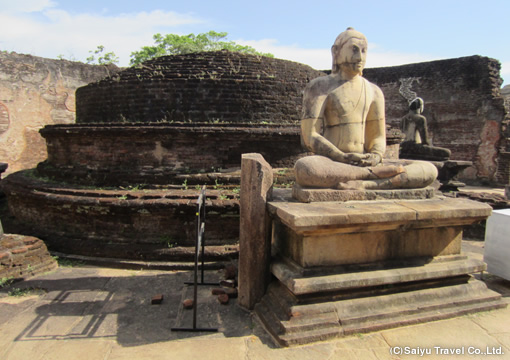
Circular pagoda, Vatadage
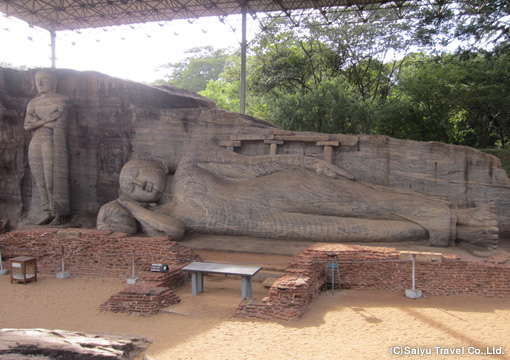
Reclining Buddha, Gal Vihara
Dambulla
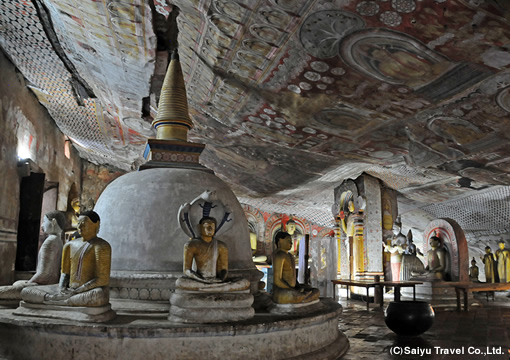
Seated statues of Buddha (in the second cave)
Dambulla is famous for its rock paintings and rock temples and is one of the most important sites for Buddhist pilgrimage and tourists visiting Sri Lanka. Dambulla leaves a lasting impression on many visitors. Entering the cool dimly lit caves there is a breathtaking array of murals and Buddhist statuary. You can see many Pilgrims clad in white and offering flowers and chanting prayers. Also Monks attired in yellow robes go about their monastic life. This heady mix of ancient art and fervent religious activity combined with the spiritual location leaves visitors overwhelmed by the experience. The caves are in a rock about 160 meters above sea level and the surrounding plain.
Geologically it is formed by a combination of two rock outcrops or inselbergs, each of domical shape. The cave temples with the paintings and statues are about halfway to the top of the hill. The caves are along the join between a rock plateau and a rock wall. A white brick verendah extends out from the rock overhang, adding a walkway outside the caves. Although the caves have been in use since pre-historic times, its ascendancy as an important monastic centre probably begins with the story of King Valagambahu also known as Vattagamini Abhaya. The King took refuge in the caves in the 1st century BC during an invasion from India. As the king fled he was mocked by a Jain priest who called out and shouted "look, the great black lion is fleeing". This statement made by the monk made the king very angry and he vowed to destroy the Jain monastery and build a Buddhist monastery in its place when he would drive away the invaders one day. The Mahavansa chronicle records that as the king fled, one of his queens Somadevi stayed behind. One of the seven invading chiefs took her as his wife and returned to India. One of the chiefs stayed behind but was slain by one of his men who assumed power. This was a pattern repeated and a succession of invaders assumed power having slain the previous holder. The king who was in hiding was protected by the monks who occupied the Dambulla rock. After fourteen years of hiding, the king emerged to drive the Indian invaders away and returned to the capital at Anuradhapura. True to his promise he destroyed the Jain temple and built a big Buddhist monastery. Although there is an absence of written records, it's generally believed, that in gratitude, he carved drip ledges and took steps to transform the caves of Dambulla into a monastery complex. Given the long history of the caves, it is not surprising that some of the frescoes on the walls are around 2000 years old. The earliest reference to the complex is in the ancient Sinhalese chronicle the Mahavansa, which refers to a Jambukola Vihara in the reign of King Vijayabahu (1055 -1100 AD). In a rock inscription made by decree of King Nissankamalla (1187-1196 AD) it is referred to as Svarnagiri Guha or the Golden Rock Temple.
Mihintale
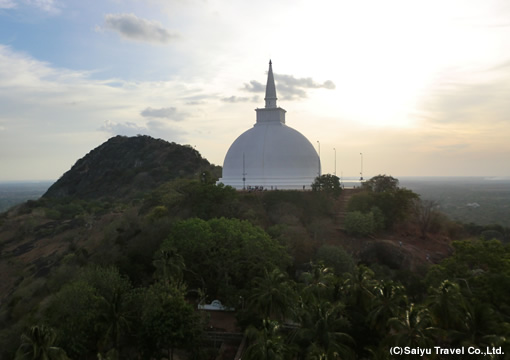
Maha Seya Dagoba
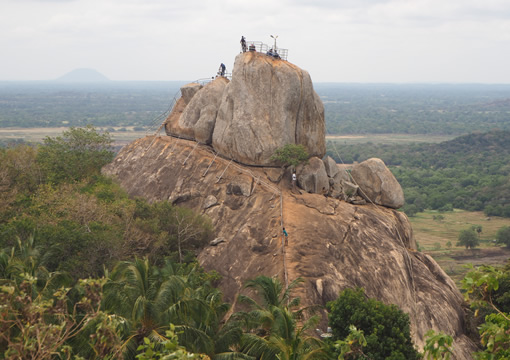
Invitation Rock
In the year 247 BC, King Devanampiyatissa who was out for hunting encountered the monk Mahinda who had been sent to Sri Lanka by his father the Emperor Asoka of India. Mahinda's mission was to convert the king of Lanka and his followers to Buddhism. Devanampiyatissa embraced the new doctrine and declared the area around Mihintale a sanctuary where no beast could be hunted. Sri Lanka has a long history of conservation. In around the 4th century BC. King Pandukabaya declared sanctuaries for the aboriginal people. In the 12th Century A.D. King Kirti Nissankamalla decreed that no animal should be hunted within 7 gav (36 km) of the City of Anuradhapura.
This is one of the most important cultural sites in Sri Lanka as Mihintale is recognized as the cradle of Buddhism in Sri Lanka. Legend has it that Devanampiyatissa, the son of Mutasiva, was a pious and wise man and that on his ordination as king precious gems and minerals sprouted on to the surface. There may be some truth underlying these legends as Sri Lanka is the fifth largest producer of gems in the world. The legend may be related to the discovery of a gem rich area at the time of the king's coronation.
The king was too modest to accept all this for himself and sent a delegation of ambassadors laden with gifts to the court of the Emperor Asoka. They were entertained for five months in his court and sent back with the message that the great Emperor Asoka had embraced Buddhism and the recommendation that Devanampiyatissa does likewise. The message seems to have fallen on deaf ears. Deciding more persuasion was needed, Asoka sent his own son Mahinda, and daughter Sangamitta who had also adopted the faith and become a monk and nun. In 247 BC Mahinda with the monks Iththiya, Uttiya, Sambala, Baddhasala and Sumana Samanera alighted on the Aradhanagala Peak at Ambasthala in Mihintale.
Legend has it that Devanampiyatissa was pursuing a deer with a hunting party when he heard his name called out. Hearing his fist name being called out the king turned in astonishment to see who would have the courage to call him by his first name. After meeting the King Devanampiyatissa and his Ministers, Mahinda Thera converted them to Buddhists and established Buddhism as the religion of the people.
The Chetiyapabbata Vihara on the missaka Pabbata was founded by King Devanampiyatissa (250-210 BC) and presented to Arahat Mahinda. The chronicles record that Mahinda learnt the local language and was very successful in converting the masses. He also translated from Pali into Sinhala the Thripitaka or the sacred cannons as well as an accompanying commentary the Aththakatha. Devanampiyatissa accepted plans from Mahinda to build thirty two stupas and personally cut the first furrows in to the earth using golden plough drawn by two elephants. The Mihintale complex grew rapidly to a center of Buddhism. However Mahinda could not ordinate women and therefore his sister Sangamitta the nun followed him later. Her visit was all the more momentous because she brought a branch of the sacred Bodi tree under which the Buddha attained Nirvana.
Chronicles record that the great Asoka cut the branch himself and took it on boards a vessel berthed on the Ganges.He accompanied it up to the point of departure on the open seas. When the vessel arrived in Sri Lanka, Devanampiyatissa dashed into the water and began chanting piously. The sapling was carried in pomp and planted in the then capita of Anuradhapura. The tree is still alive today and is the oldest historically recorded tree.
The childless Devanampiyatissa passed away and was succeeded by his younger brother Uttiya. Mahinda survived another eight years and on his death was cremated with much pomp. Some believe that his remains are enshrined in the Mihindu Seya. Fa-Hien says that there were about 2000 Bhikkus at the time of his visit to Mihintale during his two years on the island between 411 and 413 AD. King Parakramabahu (1153-1186 AD) is said to have restored sixty four chetiyas at Mihintale. In the 5th Century AD. Mihintale passed into the hands of Mahayanists of the Abayagiriya Vihara.
Trincomalee
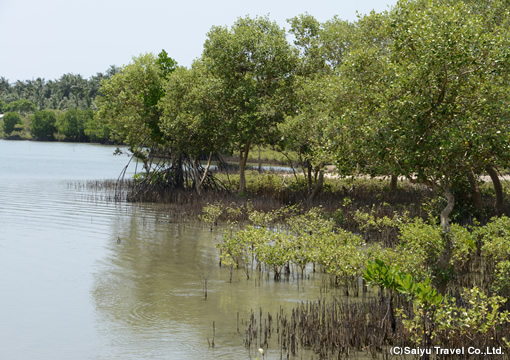
Mangrove forest
【Fort Frederick】
Originally built by the Portuguese, Fort Frederick, on the spit of land pointing east into the sea, is used by the military but usually visitors are allowed to walk through the fort in order to visit the Koneswaram Kovil (temple) at the end of the spit. This temple is very popular with Pilgrims. You are not allowed to bring a camera. Few foreigners also do visit the temple.
【Swami Rock】
At the end of the road through the fort is Swami Rock. The end of the spit is occupied by a Hindu temple (Koneswaram). Swami Rock is also known as "Lover's Leap", from the story of a Dutch officials daughter who, watching her faithless lover sail away, decided to make the fatal leap. Her father erected a pillar at the time simply because he was rather fond of her.
【Dutch Bay】
The Dutch Bay at Trinco can suffer from a very dangerous undertow, so take great care is to be taken if you want to go swimming there. The best beaches in the Trinco area for swimming are to the north of the city, particularly at Nilaveli.
Kinniyai.
8kms northwest of Trinco, are some hot wells which legend relates were created by Vishnu to distract the demon king Rawana, who named his mother, thinking that she had died. There is no place to soak here but you can slosh with buckets of hot water.
【The Commonwealth War Cemetery】
It is about 4.5 km north of Trinco on the Nilaveli road is the last resting place for many servicemen who died at Trinco during the WWII. It's beautifully kept and the friendly caretaker, who lives next door can show you a record of exactly who's buried where, may be if you would wish to locate a particular grave. A surprising number of foreigner's visit this spot.
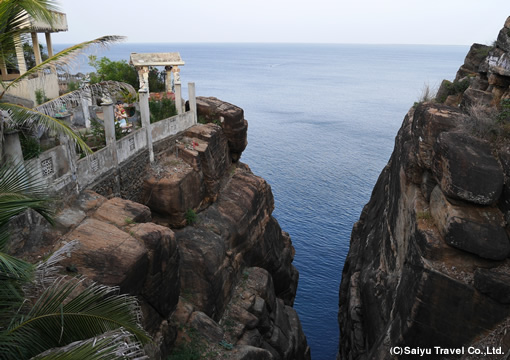
Koneswaram Kovil
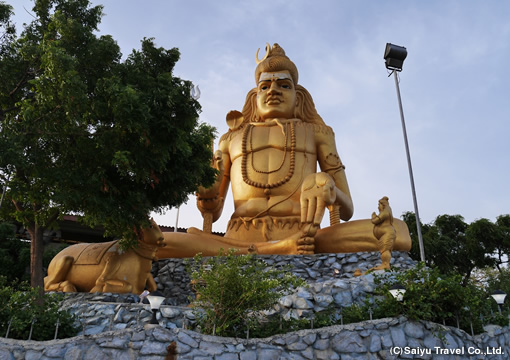
Koneswaram Kovil
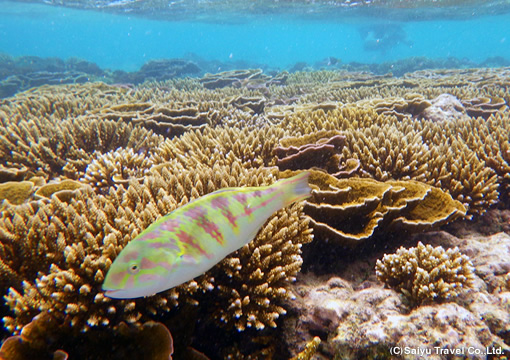
Snorkeling in Pigeon Island
Kandy and Hill country
Kandy
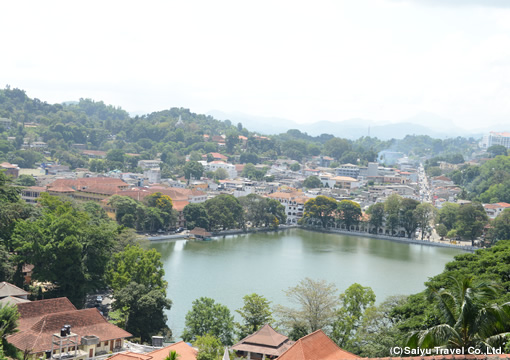
Townscape of Kandy
The Sacred Tooth Relic, which is housed in the Temple of the Tooth in Kandy also known as Sri Dalada Maligawa, is an object of veneration to Buddhists and the most important sacred relic in the country. The temple is one of the most sacred places for the Buddhists from all over the world. From ancient times kings have kept the Sacred Tooth Relic in their kingdoms as a symbol of power. As per the Historic records it is said that the Tooth Relic was first brought to the Island of Sri Lanka by Prince Dhantha and Princess Hemamali during the reign of King Kirti Sri Meghavanna around (301 - 328 AD). It is traditionally believed that, whoever takes possession of the Tooth Relic, ruler or invader, has the power to rule the people.
In the picturesque hills of the Central Province of Sri Lanka lies Kandy, the last capital of the kings. Here, an annual national festival of great magnitude and magnificence, the Kandy Perahera, combines religious, cultural, and historical aspects. It is also known as the Sri Dalada Maligawa Perahera; perahera signifies "a procession," and Dalada Maligava means "Temple of the Sacred Tooth."
The history of this festival dates back to around fourth century CE, when King Kithsiri Megawanna received from India the Sacred Tooth, a relic of Buddha, and placed it in a casket logged in an edifice built in the third century BCE by King Devanampiyatissa, who made Buddhism the national religion of Sri Lanka. This relic became the symbol of monarchy and was venerated to invoke blessings on the king and his people. The elected king had to pay homage to this shrine before being crowned.
The Mahavansa, an ancient chronicle, records that King Kithsiri ordered that the sacred tooth be taken around his capital city of Anuradhapura once a year in a great festival. This ruling was faithfully adhered to by succeeding kings, as the fifth-century Chinese traveler Faxian confirmed. Once Anuradhapura was replaced as the capital by Polonnaruwa and then by the regional capital Kandy, it is doubtful whether the procession continued to be held annually.
The Esala Perahera, as we know it today-which combines the Buddhist rite with the four Hindu devale peraheras -was inaugurated in 1775 by King Kirthi Sri Raja-singha. At that time the Sacred Tooth relic was then carried at the head of the devale processions, but today it is replaced by a duplicate casket, which contains a few lesser relics.
The Esala Perahera is held in the lunar month of July-August. On the day following the new moon in July, an Esala tree is cut and kap planted as a vow that the perahera will be held. Owing to an overlay of Hindu influences, the processions now are confined for five days within the precincts of the four Hindu devales, or temples. On the fifth night, the four peraheras emerge into the street and combine with the Maligawa Perahera at the entrance to the Maligawa. The Randoli Perahera, which is the main one, is named after the randoli, the golden palanquins in which the queen and the monarch's concubines formerly brought up from the rear, adding luster to the pageant. The four golden palanquins now represent the four devales.
Dressed in a magnificent costume, the Nilanic places the casket on the howdah on the back of the Temple Tusker, a majestic elephant. Richly caparisoned, it moves to the rhythm of the music, walking on a white cloth (pavada), which is spread for it as a mark of respect to the relics.
The procession is flanked by dancers of several traditional schools: dancers, wearing elaborate headdresses and breastplates of multicolored beads: and performing various dance forms to name a few uddekki dance; pantheru dance; naiyandi dance and so on, who perform in the Visnu (Vishnu) and Kataragama devales. Devales are small shrines
This awe-inspiring procession, with more than a hundred elephants, wends its way through the streets for five nights. It concludes with a day perahera and water cutting ceremony in the Mahaveli River. The perahera then breaks up, and each devale procession goes back to its respective devale.
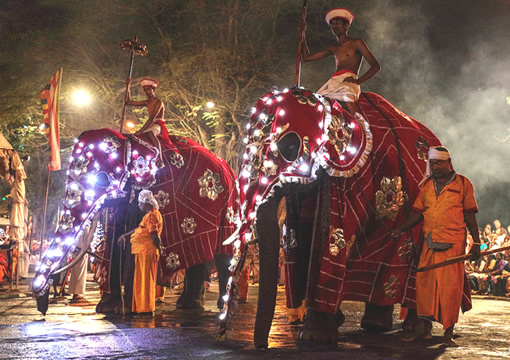
Esala Perahera
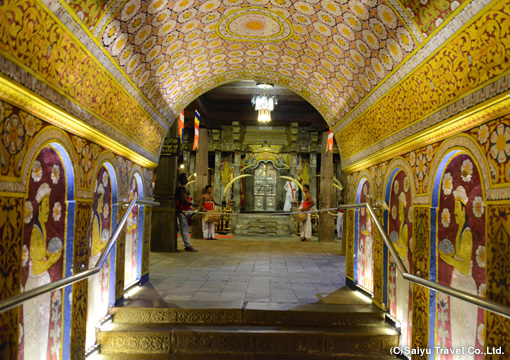
Temple of the Tooth
Queen’s hotel in Kandy is the most venerable hotel in Sri Lanka. The pure white European appearance resembles the Colonial era. Other side of the Kandy Lake, which stands out the beauty of Kandy, stands Hotel Suisse. It is a classic hotel and the movie director Steven Spielberg stayed when he was filming a movie.
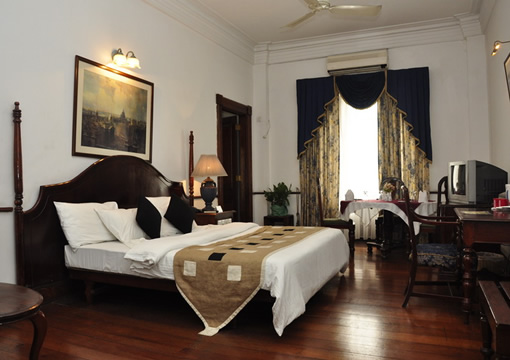
Queen’s Hotel
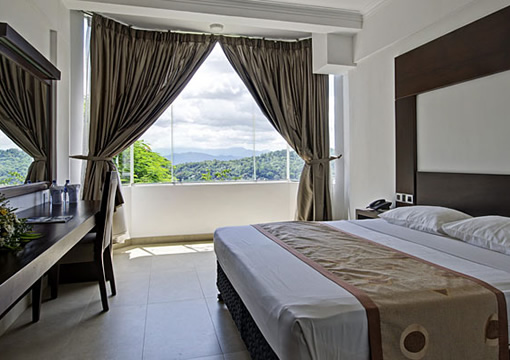
Queen’s Hotel
Nuwara Eliya
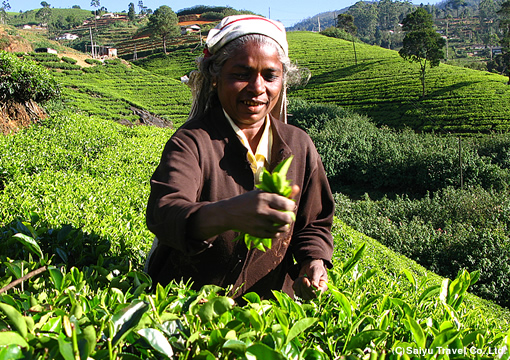
Tea plantation in Nuwara Eliya.
Nuwara Eliya is located at the south side of central highlands in Sri Lanka, 1800m above sea level. This area was discovered by an English Explorer Samuel Baker in 1846. The whether is about 16 degrees Celsius all-year around, so it is easy to spend the time. England ruler and tea plantation managers whom dominated Sri Lanka back than, settled at this area and built a cityscape close to ones similar to their home country. The settler hunted fox, deer and elephants, enjoyed polo, golf and crickets in Nuwara Eliya. Nowadays, there are clubs, racecourses and golf courses still left as they were at that time. Nuwara Eliya is very famous for locality of tea, also called the little England. The mountains of Nuwara Eliya is filled with tea plant with dazzling green color from the top to the bottom of the mountain. This scene of lining up orderly makes you want to breathe deep. Some tea factories let you see and visit their working process. You will be able to see people plucking tealeaves in the tea plantation and tealeaves purification methods.
Sri Lanka’s railroad history is old; the service began in 1864. It was made by England’s Colonial government in purpose of carrying tea and coffee to Colombo from inland area. Currently, Sri Lanka’s railway extends radial shapely from Colombo to major cities such as Galle, Kandy, Trincomalee but it is only branching from Colombo and it cannot say that railway is developed. In 2011, Sri Lankan railway started a luxury train service for tourists. ExpoRail and Rajadhani Express are those luxury trains and there are air condition and TV service included. Meals are also included in the service too. Although it is said luxury, for example Colombo to Kandy is 1450 Rupee which is pretty reasonable. The luxury train vehicle is attached to ordinary train so the speed is not different but the view of countryside of Sri Lanka that can be seen from the train ride will be a valuable experience. Above all, the train rides to middle south highland area town Badulla, in the way passing through Nuwalla Eliya you can enjoy the view of the gentle hills filled with tea plantations with a cool breeze while riding the train. You can forget the heat and enjoy the atmosphere. We recommend you to make your reservation fast, or the seats might not be available since it is a popular train ride.
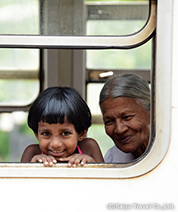
There is a hotel remodeled what used to be a tea factory; Heritance Tea Factory. The facilities for tea factory are decorated as a hotel’s interior just as they were. There is a mini factory where you can make your own tea. Other there is a hotel the Grand Hotel; that used to be Sir Edward Barnes villa, who was the Governor of Sri Lanka. Each room has a Colonial interior, especially suite rooms have a gorgeous furniture and fireplace which reminds of the Colonial period. In the other side of the hotel, there is 100 years history golf club, The Nuwara Eliya Golf Club. Also, there are small mansion-style guest house and lodge-style guest house in the town.
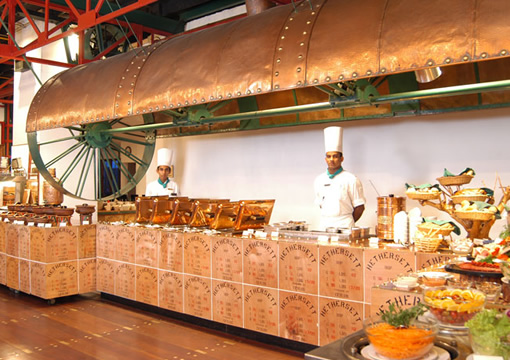
Heritance Tea Factory
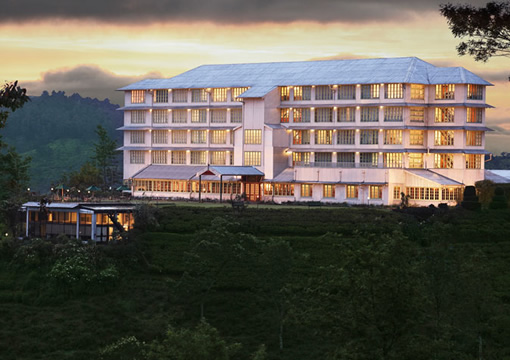
Heritance Tea Factory
Galle and Surrounding area
Galle
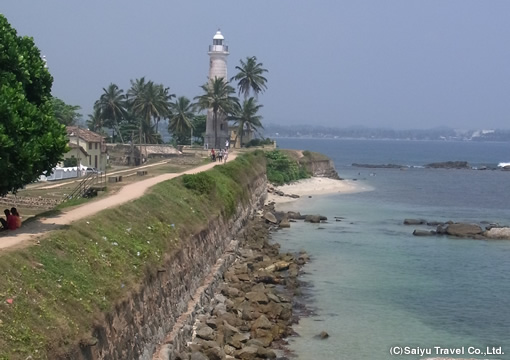
Galle’s lighthouse
Galle is located on the south of southwest coast in Sri Lanka. It is not a big town, but it is one of the best tourist spot in Sri Lanka that you must visit. The best highlights are the old town of Galle and its fortifications which is a world heritage site. The Portuguese was the first to built fortress in 1589. After that, it was extension by Dutch in 1640 and they built a town inside. Next, Galle became under the rule of England but the English did not do anything to the fortress and only used the town as a center of administrative. When entering the old town main gate, you will first spot a Clock Tower built by stone. In front, there is Bank of Ceylon. When you walk along the fort there will be Star Bastion and Aelous Bastion. When you go up on a fort you can see the wide Indian Ocean spread out. In the tip of the cape of Galle peninsula, there is an 18 meters high pure white lighthouse. This is the landmark of Galle. There is a small beach under the lighthouse where gets crowded with local bathers. Other, you can see young people jumping into the ocean from the fort or enjoying cricket at the lawn under the lighthouse. You will see churches and Mosques more often so Galle has less Buddhist space than other cities in Sri Lanka. Stylish cafes, restaurants, goods shops and souvenir shops stand side by side in the town. There are terminals of transportation facilities such as railroads and bus stops at a new town located on the northern area of Galle peninsula. Banks, post offices and police stations are lined up too. There are also markets where you can buy goods such as vegetables & fruits, lottery booth, internet café and shops where you can buy snacks. It is a convenient area filled with local people power.
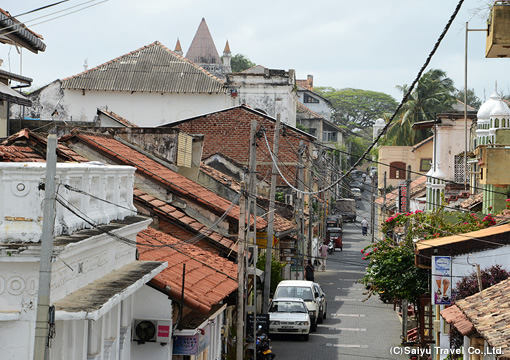
Galle’s townscape
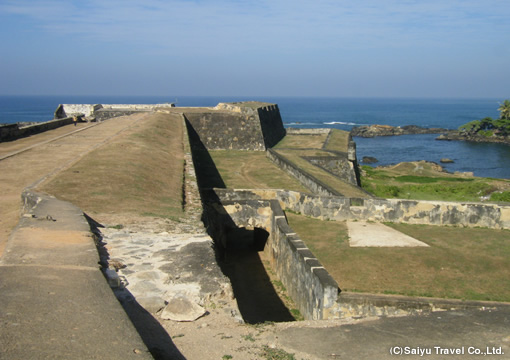
Galle’s Sun Bastion
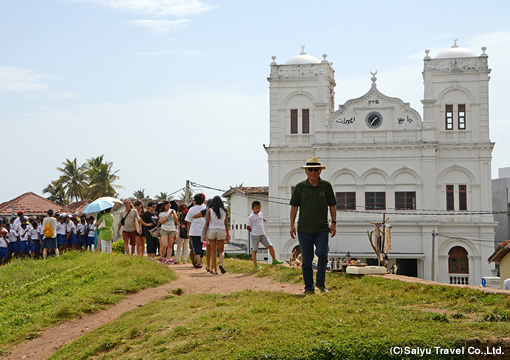
Mosque
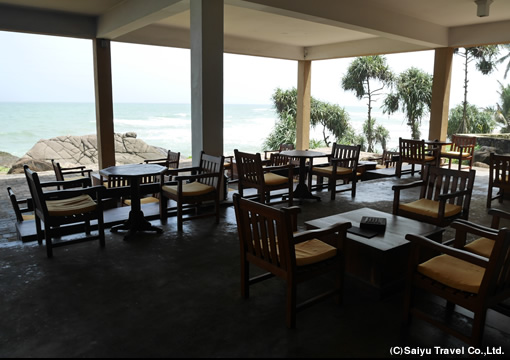
Jetwing Lighthouse
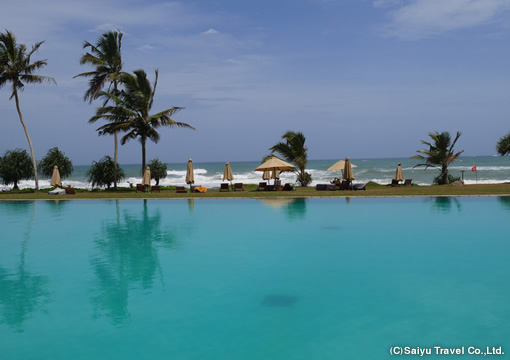
Jetwing Lighthouse
Mirissa
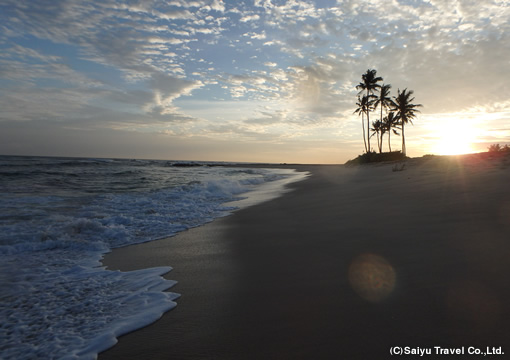
Beautiful beach with few people
Mirissa is a town located near Matara; most southern area in Sri Lanka. It is a small town compared to Galle or Matara, but there is a beautiful beach with few people and Mirissa is the base for whale-watching in Sri Lanka. Mirissa gets crowded with tourists during the best season, harbor filled with boats for whale-watching. This Mirissa and Dondora (about 5 km southeast of Matara) is famous for Blue Whales, the biggest animal in the world. Other than Blue Whales you can see Sperm whale, dolphins and Cetacean. Blue Whales habitat around this Marine area all year around, but it is said that December to April is the best season. However, June to July is not a good season for whale watching because of the impact that southwest monsoon brings to the ocean. We recommend Mirissa for those who are looking for a quiet beach stay, less people than southwest beach like Hikkaduwa.
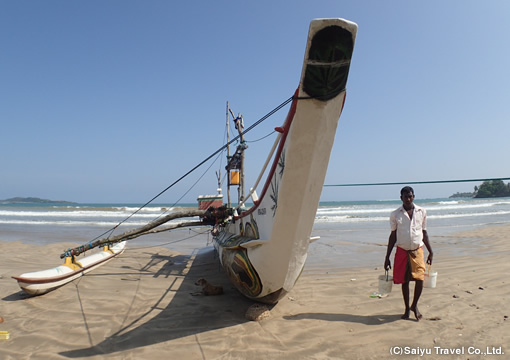
Catamaran
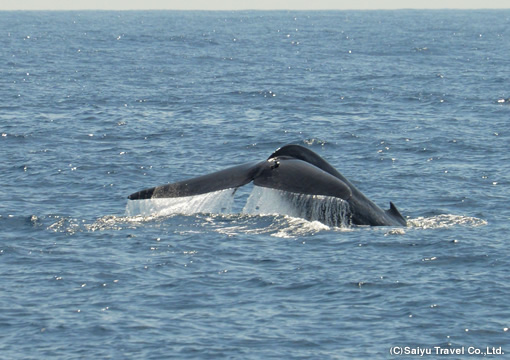
Blue Whale
[Paradise Beach Club] is the hotel that is located in Mirissa bay, which we highly recommend to those whom wish for simple and reasonable stay. You can walk to a harbor which is base of whale watching. We also recommend Mandara Resort for whale watching tourists that has excellent facilities.
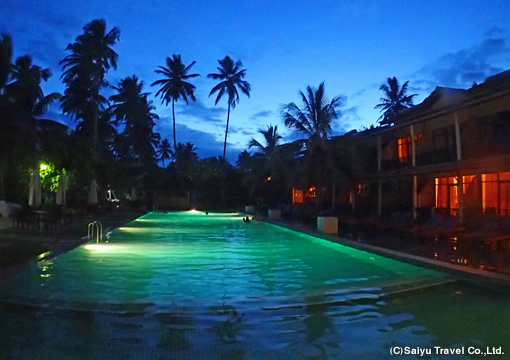
Paradise Beach Club
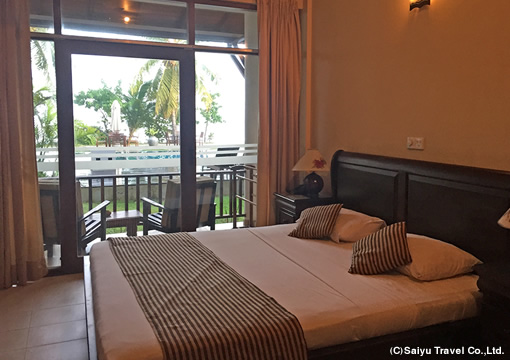
Paradise Beach Club
Hikkaduwa
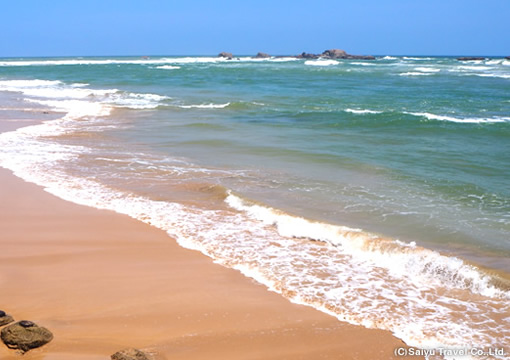
Hikkaduwa Beach
Hikkaduwa is a city in Galle (Sri Lanka’s southwest coast) which is a popular Resort for back-packers. You can experience marine sports such as diving and surfing. It is said that among the southwest coast, Hikkaduwa has coral reefs on the offshore so it developed as a Resort. There are many hotels lined up in the sea to view Coral Reef Ocean. To enjoy the ocean of Hikkaduwa by snorkeling and glass bottom boats are popular. Also, at a seacoast near Hikkaduwa is well known for sea turtles laying eggs on a full moon. When you move on south from Hikkaduwa, there is Wewala district. This district used to be a Hippie cultural area, and there are many guest houses, restaurants, bars and souvenir shops lined up tightly. It has the most Hippie town aspect in Sri Lanka. Narigama district further south, its beach is known as a Mecca of surfing. You can see many young people diving into the sea with there surfboards.


